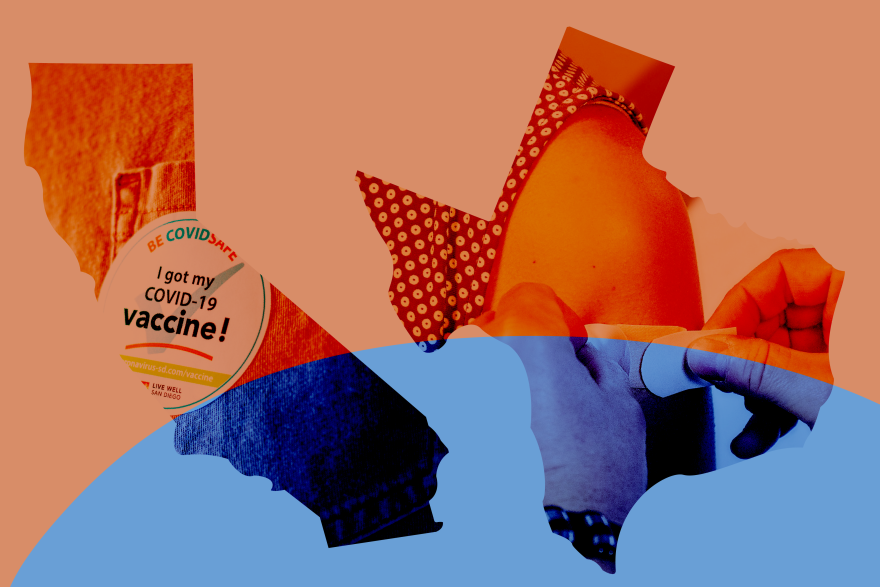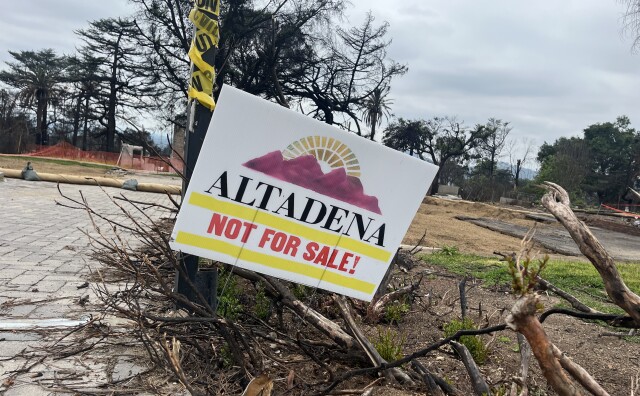Congress has cut federal funding for public media — a $3.4 million loss for LAist. We count on readers like you to protect our nonprofit newsroom. Become a monthly member and sustain local journalism.
California and Texas Took Different Routes to Vaccination. Who’s Ahead?

California has trumpeted its reliance on science and policies it says are aimed at improving social equity.
Texas state officials have emphasized individual rights and protecting the economy, often ignoring public health warnings but encouraging vaccination — while calling it a personal choice.
Yet California’s commitment to equity doesn’t appear to have put the state ahead of Texas in vaccinating Latinos, who make up roughly 40% of the population in both states. Latinos have suffered disproportionately from covid because the poorest tend to live in crowded housing, get less quality health care and have been more likely to work outside the home.
In California, 22% of Hispanics had been vaccinated as of April 12; in Texas, 21%.
Texas, in general, has done much better than California at reaching highly vulnerable groups during the first months of vaccine distribution, according to a recent analysis by the Centers for Disease Control and Prevention. Texas was seventh on the list; California was fifth from last.
Overall, however, California’s pandemic metrics have been better. As it opened vaccine eligibility to all ages on April 15, 49% of Californians 16 and older were either partially or fully vaccinated, compared with 43% of Texans.
The two states were neck and neck until a harsh winter storm in February knocked out power for a week in much of Texas. “We never really recovered after that, and exactly why, beyond our size, is not entirely clear,” said Dr. Peter Hotez, dean for the National School of Tropical Medicine at Baylor College of Medicine.
California is also doing much better when it comes to driving down infections. The state’s seven-day average is 52.7 cases and 1.8 deaths per 100,000 as of April 15, with a seven-day average positivity rate of 1.5%. Texas, meanwhile, is at 73.3 cases and 1.5 deaths per 100,000, with a seven-day average positivity rate of 7%.
The states’ leaders have reacted differently to those metrics. California Gov. Gavin Newsom has set June 15 as the day to end most pandemic restrictions, barring major setbacks, but he plans to continue to require mask-wearing in public and in high-risk workplaces. Meanwhile, Texas Gov. Greg Abbott on March 10 allowed all businesses to fully reopen and lifted a statewide mask mandate.
The concept of individual freedom plays well in Texas politics and has been front and center throughout the pandemic and the vaccine rollout. While encouraging Texans to protect themselves against the spread of the coronavirus, state officials at the same time have fought local authorities’ efforts to enforce such measures.
While Newsom instituted one of the earliest and strictest state lockdowns in the country on March 19, Texas Attorney General Ken Paxton initially called local mask mandates and business restrictions “unlawful and unenforceable.” Abbott finally instituted a mask mandate and other restrictions in July after a surge of the disease. Those measures met opposition within his own party, with Texas Republican Chair Allen West leading a protest outside the governor’s mansion in October.
Against this tense political backdrop, Texas state leaders have been softer in their vaccination messaging compared with California. Both governors received their vaccinations on live TV, but each has offered different messaging about how their constituents should view the shots.
In an April 8 tweet, Abbott celebrated the state’s reaching 13 million vaccinations, adding, “These vaccine shots are always voluntary.” That soft-pedaled message also comes through in Abbott’s stance on masks. Despite lifting the order in early March, the governor still urges residents to use them.
Public health experts in Texas have been frustrated by what they see as a half-hearted endorsement of public health measures. “It’s psychotic to have to listen to two very different messages,” said Dr. Andrea Caracostis, CEO of the HOPE Clinic in Houston, which serves minorities and immigrants. “Vaccines were not made just for your individual protection. They were made for community benefit. It is a message that has been lost in our society.”
Newsom, on the other hand, talks about vaccines in terms of responsibility to others. “Getting vaccinated is a vital step we can take to protect ourselves, our loved ones and our community, and brings us that much closer to ending this pandemic,” Newsom said on April 1, when he received his vaccination.
Newsom’s oft-repeated “north star” value is equity — the notion that the well-being of those hurt most by the pandemic should be essential to the battle against it. Starting March 4, his administration allocated 40% of its vaccines to neighborhoods that have seen 40% of covid cases and deaths. California has also invested $52.7 million to fund more than 300 “trusted messenger” community organizations to do outreach on vaccines. He didn’t make the general public eligible for vaccination until April 15 in order to prioritize more vulnerable and at-risk groups. Texas, meanwhile, fully opened the vaccine spigot on March 29.
California’s struggles to vaccinate racial and ethnic minorities and the most vulnerable, despite intense public health investment and attention to these communities, raises questions about the state’s vaccine eligibility decisions, said Elizabeth Wrigley-Field, assistant professor of sociology at the University of Minnesota.
Both Texas and California, like many states, first vaccinated health care workers and long-term care residents, populations that are majority white. But in Texas, people with underlying medical conditions — like Type 2 diabetes, sickle cell disease or obesity — also became eligible for a shot Dec. 29.
In California, people with underlying medical conditions weren’t added to the eligibility list until mid-March, and the list of underlying conditions was much more stringent than Texas’ guidelines.
“That gap between January and mid-March, that’s kind of the story to me,” Wrigley-Field said.
California officials decided Jan. 13 to prioritize people over 65. Many over-65 whites were at substantially lower risk than younger people of color, said Wrigley-Field, who argues that that age-based eligibility benefited older, white populations at the expense of younger people of color who were more at risk of covid hospitalization and death.
Prioritizing those over 65 immediately put Hispanics at a 2-to-1 disadvantage to whites, concluded Thomas Selden, based on research conducted with co-authors at the Agency for Healthcare Research and Quality (their conclusions don’t necessarily represent AHRQ or HHS). Priority tiers for those with certain diseases and essential workers would have benefited the poor and Hispanics, respectively, and pushing them down the list “could be one of the factors why we’re seeing lower rates for these groups,” he said.
Hispanics ages 20-54 in California were 8.5 times more likely to die of covid than whites of the same age from March to July, according to a University of Southern California study.
In mid-February, first responders and workers in education, food and agriculture became eligible for vaccination in California. County health departments were permitted to set their own schedules, however, and in Los Angeles these essential workers weren’t eligible until March 1 due to limited vaccine supply.
In effect, from December until March there was no eligibility tier that prioritized groups that were predominantly Latino or Black in the state’s largest county and the epicenter of the state’s covid cases and deaths.
The state’s approach harmed efforts to reach out to Latinos, some county health departments say. In Kern County, Latinos make up 53% of the population and 57% of covid cases, but got only 36% of the vaccines administered as of April 15. Confusion over the essential-worker eligibility tiers caused many to think it wasn’t their “turn,” said Brynn Carrigan, the county public health director.
Dr. Tomás Aragón, state public health officer and director of the California Department of Public Health, defended the state’s initial age-based approach and said it was a strategy to make sure Latinos were prioritized. He noted that, while Latinos accounted for 48% of the state’s covid deaths, the majority of those deaths occurred in people over 65.
“We are in a significantly better place today than many states, not just because our vaccine strategy saved lives and kept people out of hospitals, but also because we focused on proven public health interventions, such as masking, distancing, hand washing and tracing,” Aragón said in an emailed statement.
Vaccine hesitancy among racial and ethnic minorities has faded as educational outreach has ramped up, access has improved, and more people see friends and neighbors safely get the shot. Vaccine hesitancy instead appears high among Republicans, particularly white evangelicals, according to several polls.
But confidence in vaccines is growing even among Republicans, according to a poll recently conducted by Frank Luntz and released by the de Beaumont Foundation. It showed that 38% of Trump voters and 48% of Biden voters were more likely to get vaccinated than they were in March.
While some experts said consistent messaging from politicians would be helpful, time and experience watching friends and family safely receive vaccinations as well as communication with trusted individuals — particularly personal doctors — is the most effective way to overcome lingering concerns about the shots.
“What’s going to change that is getting vaccine more readily available to primary care providers … who they trust and get their questions answered, because I think they are vaccine-hesitant versus anti-vaccination,” said Dr. David Lakey, chief medical officer at the University of Texas System.
This story was produced by KHN (Kaiser Health News), a national newsroom that produces in-depth journalism about health issues. Together with Policy Analysis and Polling, KHN is one of the three major operating programs at KFF (Kaiser Family Foundation). KFF is an endowed nonprofit organization providing information on health issues to the nation.
As Editor-in-Chief of our newsroom, I’m extremely proud of the work our top-notch journalists are doing here at LAist. We’re doing more hard-hitting watchdog journalism than ever before — powerful reporting on the economy, elections, climate and the homelessness crisis that is making a difference in your lives. At the same time, it’s never been more difficult to maintain a paywall-free, independent news source that informs, inspires, and engages everyone.
Simply put, we cannot do this essential work without your help. Federal funding for public media has been clawed back by Congress and that means LAist has lost $3.4 million in federal funding over the next two years. So we’re asking for your help. LAist has been there for you and we’re asking you to be here for us.
We rely on donations from readers like you to stay independent, which keeps our nonprofit newsroom strong and accountable to you.
No matter where you stand on the political spectrum, press freedom is at the core of keeping our nation free and fair. And as the landscape of free press changes, LAist will remain a voice you know and trust, but the amount of reader support we receive will help determine how strong of a newsroom we are going forward to cover the important news from our community.
Please take action today to support your trusted source for local news with a donation that makes sense for your budget.
Thank you for your generous support and believing in independent news.

-
Experts say students shouldn't readily forgo federal aid. But a California-only program may be a good alternative in some cases.
-
The program is for customers in communities that may not be able to afford turf removal or water-saving upgrades.
-
More than half of sales through September have been to corporate developers. Grassroots community efforts continue to work to combat the trend.
-
The bill would increase penalties for metal recyclers who possess or purchase metal used in public infrastructure.
-
The new ordinance applies to certain grocers operating in the city and has led to some self-checkout lanes to shutter.
-
Children asked to waive right to see a judge in exchange for $2,500







